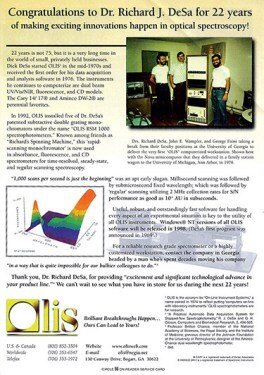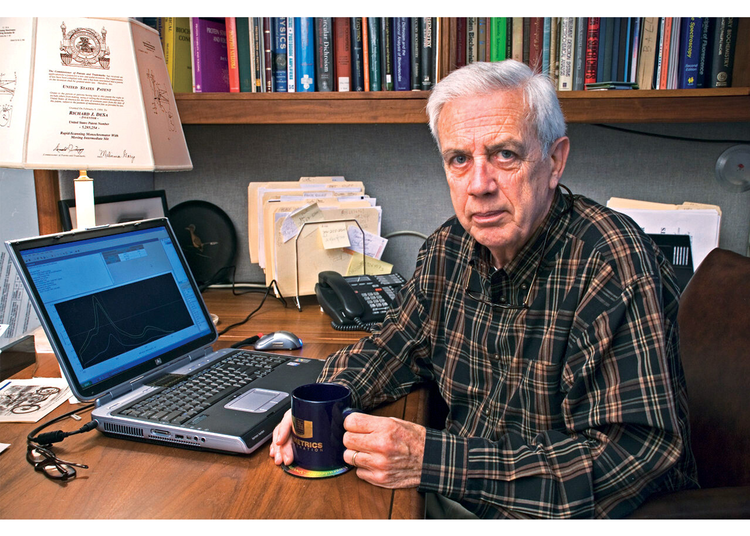How Circular Dichroism can Save You Time, Stress, and Money.
Wiki Article
Rumored Buzz on Circularly Polarized Luminescence
Table of ContentsCircular Dichroism - Questions6 Simple Techniques For Circularly Polarized LuminescenceCircularly Polarized Luminescence for BeginnersThe Only Guide for SpectrophotometersUv/vis Fundamentals ExplainedCircular Dichroism Fundamentals ExplainedTop Guidelines Of Uv/visOur Uv/vis StatementsNot known Factual Statements About Uv/vis/nir The 2-Minute Rule for Uv/visSpectrophotometers Fundamentals ExplainedThe 9-Minute Rule for Uv/vis/nirAn Unbiased View of Circularly Polarized Luminescence
It is then scanned through the sample and the reference solutions. Fractions of the event wavelengths are sent through, or reflected from, the sample and the referral. The resultant light strikes the photodetector gadget, which compares the relative intensity of the 2 beams. Electronic circuits transform the relative currents into direct transmission portions and/or absorbance/concentration worths.The transmission of a referral compound is set as a baseline (datum) value, so the transmission of all other substances are recorded relative to the preliminary "zeroed" compound. The spectrophotometer then converts the transmission ratio into 'absorbency', the concentration of specific components of the test sample relative to the initial compound.
Considering that samples in these applications are not easily offered in big quantities, they are specifically suited to being evaluated in this non-destructive method. In addition, precious sample can be conserved by utilizing a micro-volume platform where as little as 1u, L of sample is required for complete analyses. A brief explanation of the procedure of spectrophotometry includes comparing the absorbency of a blank sample that does not contain a colored compound to a sample which contains a colored substance.
The smart Trick of Circularly Polarized Luminescence That Nobody is Talking About
In biochemical experiments, a chemical and/or physical home is selected and the treatment that is utilized is particular to that residential or commercial property in order to obtain more info about the sample, such as the amount, purity, enzyme activity, etc. Spectrophotometry can be used for a number of strategies such as identifying optimal wavelength absorbance of samples, figuring out optimum p, H for absorbance of samples, figuring out concentrations of unidentified samples, and determining the p, Ka of different samples.: 21119 Spectrophotometry is also a handy process for protein filtration and can also be used as a method to create optical assays of a compound.It is possible to understand the concentrations of a two part mix using the absorption spectra of the standard solutions of each element. To do this, it is required to understand the extinction coefficient of this mixture at two wave lengths and the extinction coefficients of options which contain the recognized weights of the two parts.

Some Ideas on Spectrophotometers You Need To Know
Area. The concentration of a protein can be estimated by determining the OD at 280 nm due to the existence of tryptophan, tyrosine and phenylalanine.This technique requires a spectrophotometer capable of measuring in the UV region with quartz cuvettes.: 135 Ultraviolet-visible (UV-vis) spectroscopy involves energy levels that delight electronic transitions. Absorption of UV-vis light delights molecules that are in ground-states to their excited-states.
These curves can be used to check a brand-new batch of colorant to examine if it makes a match to specs, e
Traditional visible region spectrophotometers can not detect if identify colorant or the base material has fluorescence. This can make it difficult to handle color issues if for example one or more of the printing inks is fluorescent. There are 2 significant setups for visual spectrum spectrophotometers, d/8 (round) and 0/45.
Scientists use this instrument to determine the quantity of compounds in a sample. If the substance is more focused more light will be absorbed by the sample; within little varieties, the Beer, Lambert law holds and the absorbance between samples differ with concentration linearly. When it comes to printing measurements two alternative settings are typically used- without/with uv filter to control much better the impact of uv brighteners within the paper stock.
Excitement About Circularly Polarized Luminescence
Some applications require small volume measurements which can be carried out with micro-volume platforms. As described in the applications section, spectrophotometry can be utilized in both qualitative and quantitative analysis of DNA, RNA, and proteins. Qualitative analysis can be utilized and spectrophotometers are utilized to tape-record spectra of substances by scanning broad wavelength areas to figure out the absorbance residential or commercial properties (the strength of the color) of the compound at each wavelength.
Little Known Facts About Uv/vis/nir.
One significant factor is the type of photosensors that are readily available for various spectral areas, however infrared measurement is also tough due to the fact that virtually whatever discharges IR as thermal radiation, specifically at wavelengths beyond about 5 m. Another complication is that many products such as glass and plastic absorb infrared, making it incompatible as an optical medium.Samples for IR spectrophotometry might be smeared in between two discs of potassium bromide or ground with potassium bromide and pressed into a pellet. Where liquid options are to be measured, insoluble silver chloride is utilized to construct the cell. Spectroradiometers, which run almost like the noticeable area spectrophotometers, are designed to measure the spectral density of illuminants. Obtained Dec 23, 2018. Fundamental Laboratory Approaches for Biochemistry and Biotechnology (2nd ed.). The necessary guide to analytical chemistry.
Oke, J. B.; Gunn, J. E.
Our Circularly Polarized Luminescence Statements

1021/ac50048a728. ISSN0003-2700. Ninfa AJ, Ballou DP, Benore M (2015 ). Fundamental Laboratory Techniques for Biochemistry and Biotechnology (3, rev. ed.). Hoboken, NJ: Wiley & Sons. p. 77. ISBN9780470924525. OCLC915641828. "Fully Automatic Double Beam - Atomic Absorption Spectrophotometer (AA 8000)". Lab Devices. Labindia Analytical Instruments Pvt. Ltd. "Spectrophotometry Applications and Principles".
8 Simple Techniques For Circular Dichroism
Obtained Jul 4, 2018. Trumbo, Toni A.; Schultz, Emeric; Borland, Michael G.; Pugh, Michael Eugene (April 27, 2013). "Applied Spectrophotometry: Analysis of a Biochemical Mixture". Biochemistry and Molecular Biology Education. 41 (4 ): 24250. doi:10. 1002/bmb. 20694. PMID 23625877. (PDF). www. mt.com. Mettler-Toledo AG, Analytical. 2016. Retrieved Dec 23, 2018. Cortez, C.; Szepaniuk, A.; Gomes da Silva, L."Exploring Proteins Filtration Methods Animations as Tools for the Biochemistry Mentor". Journal of Biochemistry Education. 8 (2 ): 12. doi:. Garrett RH, Grisham CM (2013 ). Biochemistry. Belmont, CA: Cengage. p. 106. ISBN 978-1133106296. OCLC 801650341. Holiday, Ensor Roslyn (May 27, 1936). "Spectrophotometry of proteins". Biochemical Journal. 30 (10 ): 17951803. doi:10. 1042/bj0301795.
PMID 16746224. Hermannsson, Ptur G.; Vannahme, Christoph; Smith, Cameron L. C.; Srensen, Kristian T.; Kristensen, Anders (2015 ). "Refractive index dispersion noticing utilizing an array of photonic crystal resonant reflectors". Applied Physics Letters. 107 (6 ): 061101. Bibcode:2015 Ap, Ph, L. 107f1101H. doi:10. 1063/1. 4928548. S2CID 62897708. Mavrodineanu R, Schultz JI, Menis O, why not check here eds.
Not known Facts About Spectrophotometers
U.S. Department of Commerce National Bureau of Standards unique publication; 378. Washington, D.C.: U.S. National Bureau of Standards. p. 2. OCLC 920079.The process starts with a controlled light source that brightens the evaluated sample. In the case of reflection, as this light engages with the sample, some is soaked up or emitted. The released light journeys to the detector, which is analyzed, measured, and presented as industry-standard color scales and indices.
All terms are assessed over the visible spectrum from 400 to 700 nm. In the case of transmission, when the light connects with the sample, it is either taken in, reflected, or transferred.
The Main Principles Of Circular Dichroism
Examples include APHA (American Public Health Association) for watercolor and purity analysis, ASTM D1500 for petrochemical color analysis, edible oil indices utilized in food, and color analyses of beverages. All terms are examined over the noticeable spectrum from 400 to 700 nm.Image Credit: Matej Kastelic/ Dr. Arnold J. Beckman and his associates at the National Technologies Laboratories first created the spectrophotometer in 1940. In 1935 Beckman established the business, and the discovery of the spectrophotometer was their most ground-breaking development.
Spectrophotometers for Dummies
99% precision. In time, scientists kept enhancing the spectrophotometer design to enhance its performance. For example, the UV capabilities of the design B spectrophotometer were improved by changing the glass prism with a quartz prism. Ultimately, the Model DU was created, consisting of a hydrogen light and other enhancements. This instrument was utilized in commercial laboratories, clinics, and chemistry and biochemistry departments.Usually, a spectrophotometer is made up of two instruments, particularly, a spectrometer and a photometer. A basic spectrophotometer includes a light source, a monochromator, a collimator for straight light beam transmission, a cuvette to put a sample, and a photoelectric detector.
Not known Details About Circularly Polarized Luminescence
There are various kinds of spectrophotometers in different sizes and shapes, each with its own purpose or performance. A spectrophotometer figures out just how much light is reflected by chemical elements. UV/Vis. It determines the difference in light strength based upon the total quantity of light introduced to a sample and the amount of light beam that goes through the sample service
According to the instrument's design, the sample is placed in between the spectrometer and the photometer. After the light is passed through the sample, the photometer determines its strength and displays the reading. A spectrophotometer is used to figure out the concentration of both colorless and colored solutes in a solution. This instrument is utilized to figure out the rate of a response.
Report this wiki page